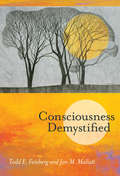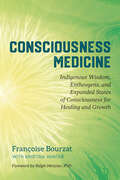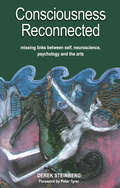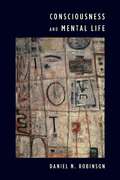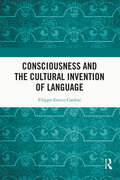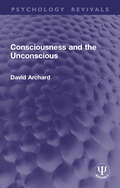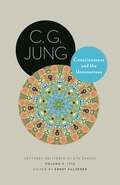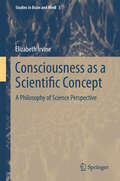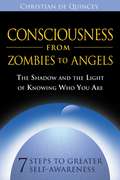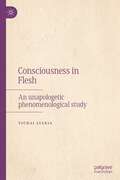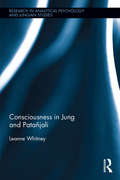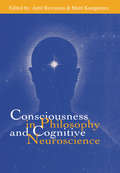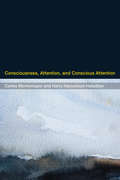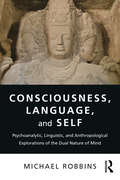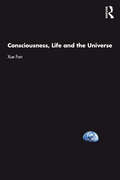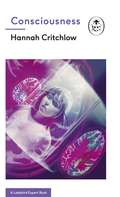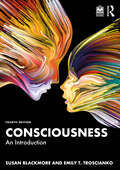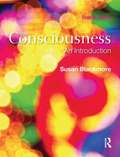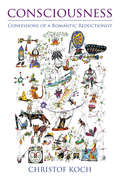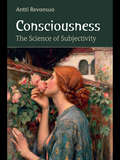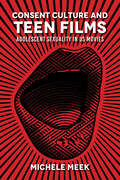- Table View
- List View
Consciousness Demystified (The\mit Press Ser.)
by Todd E. Feinberg Jon M. MallattDemystifying consciousness: how subjective experience can be explained by natural brain and evolutionary processes.Consciousness is often considered a mystery. How can the seemingly immaterial experience of consciousness be explained by the material neurons of the brain? There seems to be an unbridgeable gap between understanding the brain as an objectively observed biological organ and accounting for the subjective experiences that come from the brain (and life processes). In this book, Todd Feinberg and Jon Mallatt attempt to demystify consciousness—to naturalize it, by explaining that the subjective, experiencing aspects of consciousness are created by natural brain processes that evolved in natural ways. Although subjective experience is unique in nature, they argue, it is not necessarily mysterious. We need not invoke the unknown or unknowable to explain its creation.Feinberg and Mallatt flesh out their theory of neurobiological naturalism (after John Searle's biological naturalism) that recognizes the many features that brains share with other living things, lists the neural features unique to conscious brains, and explains the subjective–objective barrier naturally. They investigate common neural features among the diverse groups of animals that have primary consciousness—the type of consciousness that experiences both sensations received from the world and affects such as emotions. They map the evolutionary development of consciousness and find an uninterrupted progression over time, without inserting any mysterious forces or exotic physics. Finally, bridging the previously unbridgeable, they show how subjective experience, although different from objective observation, can be naturally explained.
Consciousness Explained
by Daniel C. Dennett"Brilliant...as audacious as its title....Mr. Dennett's exposition is nothing short of brilliant." --George Johnson, New York Times Book Review Consciousness Explained is a a full-scale exploration of human consciousness. In this landmark book, Daniel Dennett refutes the traditional, commonsense theory of consciousness and presents a new model, based on a wealth of information from the fields of neuroscience, psychology, and artificial intelligence. Our current theories about conscious life-of people, animal, even robots--are transformed by the new perspectives found in this book.
Consciousness Medicine: Indigenous Wisdom, Entheogens, and Expanded States of Consciousness for Healing Healing and Growth
by Françoise Bourzat Kristina HunterA comprehensive guide to the safe and ethical application of expanded states of consciousness for therapists, healing practitioners, and sincere explorers Psychedelic medicines also known as entheogens are entering the mainstream. And it&’s no wonder: despite having access to the latest wellness trends and advances in technology, we&’re no healthier, happier, or more meaningfully connected. Psilocybin mushrooms, ayahuasca, and LSD—as well as other time-tested techniques with the power to shift consciousness such as drumming, meditation, and vision quests—are now being recognized as potent catalysts for change and healing. But how do we ensure that we&’re approaching them effectively? Françoise Bourzat—a counselor and experienced guide with sanctioned training in the Mazatec and other indigenous traditions—and healer Kristina Hunter introduce a holistic model focusing on the threefold process of preparation, journey, and integration. Drawing from more than thirty years of experience, Bourzat&’s skillful and heartfelt approach presents the therapeutic application of expanded states, without divorcing them from their traditional contexts. Consciousness Medicine delivers a coherent map for navigating nonordinary states of consciousness, offering an invaluable contribution to the field of healing and transformation.
Consciousness Reconnected: Missing Links Between Self, Neuroscience, Psychology and the Arts
by Derek SteinbergWhat is consciousness? The answer to this question has eluded thinkers for millennia. In modern times, scientists have struggled to find a complete answer, often hampered by the limitations of their particular specialisms. Derek Steinberg’s unique approach constructs a multi-faceted model of mind involving science and the arts, from which the sense of personal identity emerges. In a masterful tour-de-force, he establishes links between otherwise distinct or even conflicting disciplines. In this radical departure, the author argues that the arts, literature and human culture in the broadest sense make their contributions to understanding consciousness and the sense of self, though they are rarely acknowledged in mainstream debate. Rather than focusing only on what lies between the ears, Steinberg casts a wide net. He explores the connections between sciences and the humanities as he takes the debate into new areas. This book is fascinating and enlightening reading for everyone interested in human nature and the psyche, as well as for students and professionals in the fields of neuroscience, psychiatry, psychology, medicine, social science, anthropology, philosophy and the arts, for whom the book is a breakthrough in the challenge of cross-disciplinary collaboration.
Consciousness and Mental Life
by Daniel N. RobinsonIn recent decades, issues that reside at the center of philosophical and psychological inquiry have been absorbed into a scientific framework variously identified as "brain science," "cognitive science," and "cognitive neuroscience." Scholars have heralded this development as revolutionary, but a revolution implies an existing method has been overturned in favor of something new. What long-held theories have been abandoned or significantly modified in light of cognitive neuroscience? Consciousness and Mental Life questions our present approach to the study of consciousness and the way modern discoveries either mirror or contradict understandings reached in the centuries leading up to our own. Daniel N. Robinson does not wage an attack on the emerging discipline of cognitive science. Rather, he provides the necessary historical context to properly evaluate the relationship between issues of consciousness and neuroscience and their evolution over time. Robinson begins with Aristotle and the ancient Greeks and continues through to René Descartes, David Hume, William James, Daniel Dennett, John Searle, Richard Rorty, Hilary Putnam, and Derek Parfit. Approaching the issue from both a philosophical and a psychological perspective, Robinson identifies what makes the study of consciousness so problematic and asks whether cognitive neuroscience can truly reveal the origins of mental events, emotions, and preference, or if these occurrences are better understood by studying the whole person, not just the brain. Well-reasoned and thoroughly argued, Consciousness and Mental Life corrects many claims made about the success of brain science and provides a valuable historical context for the study of human consciousness.
Consciousness and Perceptual Experience
by Thomas NatsoulasThis book describes and proposes an unusual integrative approach to human perception that qualifies as both an ecological and a phenomenological approach at the same time. Thomas Natsoulas shows us how our consciousness - in three of six senses of the word that the book identifies - is involved in our activity of perceiving the one and only world that exists, which includes oneself as a proper part of it, and that all of us share together with the rest of life on earth. He makes the case that our stream of consciousness - in the original Jamesian sense minus his mental/physical dualism - provides us with firsthand contact with the world, as opposed to our having such contact instead with theorist-posited items such as inner mental representations, internal pictures, or sense-image models, pure figments and virtual objects, none of which can have effects on our sensory receptors.
Consciousness and the Cultural Invention of Language
by Filippo-Enrico CardiniThis book studies the origins of language. It presents language as the product of a unique non-linguistic cognitive feature (i.e., metacognition) that emerged late in human evolution. Within this framework, the author lays special emphasis on the tight links that exist between language and consciousness, with the conviction that the creation of language was ultimately made possible by the onset of a new type of awareness that enabled the invention of words. The volume studies the parallels between human cultural behaviour and human language, discusses the motivational underpinnings that favoured the emergence of language, and offers a possible evolutionary timeline for the advent of language. It also addresses the questions of whether artificial intelligence will ever develop the kind of thinking and language observable in humans. A unique look into the beginnings of human language, this book will be indispensable for students and researchers of language and linguistics, language evolution, cultural studies, cognitive linguistics, psycholinguistics, and cognitive science.
Consciousness and the Self: New Essays
by John Perry Jeeloo Liu'I never can catch myself at any time without a perception, and never can observe any thing but the perception. '<P><P> These famous words of David Hume, on his inability to perceive the self, set the stage for JeeLoo Liu and John Perry's collection of essays on self-awareness and self-knowledge. This volume connects recent scientific studies on consciousness with the traditional issues about the self explored by Descartes, Locke and Hume. Experts in the field offer contrasting perspectives on matters such as the relation between consciousness and self-awareness, the notion of personhood and the epistemic access to one's own thoughts, desires or attitudes. The volume will be of interest to philosophers, psychologists, neuroscientists, cognitive scientists and others working on the central topics of consciousness and the self.
Consciousness and the Unconscious (Psychology Revivals)
by David ArchardOriginally published in 1984, Consciousness and the Unconscious deals with the concept of ‘the unconscious’ as originally defined by Sigmund Freud, and as subsequently developed, defended and criticized in continental writing at the time. It starts by describing the institutional context in which psychoanalytic theory developed, and the philosophical context which it met, and goes on to discuss Freud’s own understanding of the term ‘unconscious’. This is followed by an account of Sartre’s influential critique of Freud. In the central chapters of the book, the principal relevant ideas of Lacan, and his pupils Laplanche and Leclaire, are introduced, and the author shows how these overlook an important aspect of Freudian ideas, and rest on an incoherent theory of language and meaning. Finally, the important but neglected critique of Freud by the Italian Marxist Sebastiano Timpanaro is analysed. The conclusion summarizes the resulting problems facing Freud’s notion of ‘the unconscious’.All technical terms are explained at first use, and the author excels at making complex ideas accessible. This is an ideal introductory text for students who need a concise guide to ideas about ‘the unconscious’.
Consciousness and the Unconscious: Lectures Delivered at ETH Zurich, Volume 2: 1934 (Philemon Foundation Series #23)
by C. G. JungJung&’s lectures on consciousness and the unconscious—in English for the first timeBetween 1933 and 1941, C. G. Jung delivered a series of public lectures at the Swiss Federal Institute of Technology (ETH) in Zurich. Intended for a general audience, these lectures addressed a broad range of topics, from dream analysis and yoga to the history of psychology. They are at the center of Jung&’s intellectual activity in this period and provide the basis of his later work. Here for the first time in English is Jung&’s introduction to his core psychological theories and methods, delivered in the summer of 1934.With candor and wit, Jung shares with his audience the path he himself took to understanding the nature of consciousness and the unconscious. He describes their respective characteristics using examples from his clinical experience as well as from literature, his travels, and everyday life. For Jung, consciousness is like a small island in the ocean of the unconscious, while the unconscious is part of the primordial condition of humankind. Jung explains various methods for uncovering the contents of the unconscious, in particular talk therapy and dream analysis.Complete with explanations of Jungian concepts and terminology, Consciousness and the Unconscious painstakingly reconstructs and translates these talks from detailed shorthand notes by attendees, making a critical part of Jung&’s work available to today&’s readers.
Consciousness as a Scientific Concept: A Philosophy of Science Perspective (Studies in Brain and Mind #5)
by Elizabeth IrvineThe source of endless speculation and public curiosity, our scientific quest for the origins of human consciousness has expanded along with the technical capabilities of science itself and remains one of the key topics able to fire public as much as academic interest. Yet many problematic issues, identified in this important new book, remain unresolved. Focusing on a series of methodological difficulties swirling around consciousness research, the contributors to this volume suggest that 'consciousness' is, in fact, not a wholly viable scientific concept. Supporting this 'eliminativist' stance are assessments of the current theories and methods of consciousness science in their own terms, as well as applications of good scientific practice criteria from the philosophy of science. For example, the work identifies the central problem of the misuse of qualitative difference and dissociation paradigms, often deployed to identify measures of consciousness. It also examines the difficulties that attend the wide range of experimental protocols used to operationalise consciousness--and the implications this has on the findings of integrative approaches across behavioural and neurophysiological research. The work also explores the significant mismatch between the common intuitions about the content of consciousness, that motivate much of the current science, and the actual properties of the neural processes underlying sensory and cognitive phenomena. Even as it makes the negative eliminativist case, the strong empirical grounding in this volume also allows positive characterisations to be made about the products of the current science of consciousness, facilitating a re-identification of target phenomena and valid research questions for the mind sciences.
Consciousness from Zombies to Angels: The Shadow and the Light of Knowing Who You Are
by Christian De QuinceyA user-friendly, step-by-step guide to understanding the mind• Presents a practical journey into understanding consciousness--philosophy’s hardest problem, science’s final frontier, and spirituality’s deepest mystery• Offers 7 steps to transform your life using the shadow and the light of consciousnessConsciousness from Zombies to Angels presents a practical, step-by-step “owner’s guide” for the mind that sorts out philosophy’s hardest problem, science’s final frontier, and spirituality’s deepest mystery--what consciousness is, how it works, and why it’s important. Christian de Quincey presents seven simple steps for understanding consciousness and how it can lead to spiritual awareness: observe your language, identify the problem, learn how to look, recognize your patterns, know yourself, embrace your shadow, and practice transformation.All of us exhibit both shadow and light, aspects of ourselves we fear and deny (our inner Zombies) as well as qualities we admire and want to radiate (our inner Angels). The key to a creative and fulfilled life is to integrate both. De Quincey reveals that the way to transformation is to accept ourselves exactly as we are--a work in progress.Readers will learn the difference between “energy talk” and “consciousness talk”; how the body affects the mind, and vice versa; and where to go for help to develop consciousness, heal emotions, or grow spiritually. De Quincey shows how to recognize and break habits and patterns that run your life, how to find out who you really are, and why facing up to your darkest fears will liberate your brightest light as you learn to embrace all of your humanity and experience the power of transformation.
Consciousness in Flesh: An Unapologetic Phenomenological Study
by Yochai AtariaThis book offers an uncompromising and unapologetic phenomenological study of altered states of consciousness in an attempt to understand the structure of human consciousness. Drawing on the philosophy of Merleau-Ponty, it sets out to decipher the inextricable link between consciousness, body, and world. This link will be established through the presentation of in-depth phenomenological research conducted with former prisoners of war (POWs) and senior meditators. Focusing on two such disparate groups improves our understanding of the nature of the subjective experience in extreme situations – when our sense of boundary is rigid and we are disconnected both from the body and the world (POWs); and when our sense of boundary is fluid and we feel unified with the world (meditators). Based on empirical-phenomenological research, this book will explain how the body that is from the outset thrown into the intersubjective world shapes the structure of consciousness.
Consciousness in Jung and Patañjali (Research in Analytical Psychology and Jungian Studies)
by Leanne WhitneyThe East-West dialogue increasingly seeks to compare and clarify contrasting views on the nature of consciousness. For the Eastern liberatory models, where a nondual view of consciousness is primary, the challenge lies in articulating how consciousness and the manifold contents of consciousness are singular. Western empirical science, on the other hand, must provide a convincing account of how consciousness arises from matter. By placing the theories of Jung and Patañjali in dialogue with one another, Consciousness in Jung and Patañjali illuminates significant differences between dual and nondual psychological theory and teases apart the essential discernments that theoreticians must make between epistemic states and ontic beliefs. Patañjali’s Classical Yoga, one of the six orthodox Hindu philosophies, is a classic of Eastern and world thought. Patañjali teaches that notions of a separate egoic "I" are little more than forms of mistaken identity that we experience in our attempts to take ownership of consciousness. Carl Jung’s depth psychology, which remains deeply influential to psychologists, religious scholars, and artists alike, argues that ego-consciousness developed out of the unconscious over the course of evolution. By exploring the work of key theoreticians from both schools of thought, particularly those whose ideas are derived from an integration of theory and practice, Whitney explores the extent to which the seemingly irremediable split between Jung and Patañjali’s ontological beliefs can in fact be reconciled. This thorough and insightful work will be essential reading for academics, theoreticians, and postgraduate students in the fields of psychology, philosophy of science, and consciousness studies. It will also appeal to those interested in the East–West psychological and philosophical dialogue.
Consciousness in Philosophy and Cognitive Neuroscience
by Antti Revonsuo Matti KamppinenConsciousness seems to be an enigmatic phenomenon: it is difficult to imagine how our perceptions of the world and our inner thoughts, sensations and feelings could be related to the immensely complicated biological organ we call the brain. This volume presents the thoughts of some of the leading philosophers and cognitive scientists who have recently participated in the discussion of the status of consciousness in science. The focus of inquiry is the question: "Is it possible to incorporate consciousness into science?" Philosophers have suggested different alternatives -- some think that consciousness should be altogether eliminated from science because it is not a real phenomenon, others that consciousness is a real, higher-level physical or neurobiological phenomenon, and still others that consciousness is fundamentally mysterious and beyond the reach of science. At the same time, however, several models or theories of the role of conscious processing in the brain have been developed in the more empirical cognitive sciences. It has been suggested that non-conscious processes must be sharply separated from conscious ones, and that the necessity of this distinction is manifested in the curious behavior of certain brain-damaged patients. This book demonstrates the dialogue between philosophical and empirical points of view. The writers present alternative solutions to the brain-consciousness problem and they discuss how the unification of biological and psychological sciences could thus become feasible. Covering a large ground, this book shows how the philosophical and empirical problems are closely interconnected. From this interdisciplinary exploration emerges the conviction that consciousness can and should be a natural part of our scientific world view.
Consciousness, Attention, and Conscious Attention (The\mit Press Ser.)
by Carlos Montemayor Harry Haroutioun HaladjianA rigorous analysis of current empirical and theoretical work supporting the argument that consciousness and attention are largely dissociated.In this book, Carlos Montemayor and Harry Haladjian consider the relationship between consciousness and attention. The cognitive mechanism of attention has often been compared to consciousness, because attention and consciousness appear to share similar qualities. But, Montemayor and Haladjian point out, attention is defined functionally, whereas consciousness is generally defined in terms of its phenomenal character without a clear functional purpose. They offer new insights and proposals about how best to understand and study the relationship between consciousness and attention by examining their functional aspects. The book's ultimate conclusion is that consciousness and attention are largely dissociated. Undertaking a rigorous analysis of current empirical and theoretical work on attention and consciousness, Montemayor and Haladjian propose a spectrum of dissociation—a framework that identifies the levels of dissociation between consciousness and attention—ranging from identity to full dissociation. They argue that conscious attention, the focusing of attention on the contents of awareness, is constituted by overlapping but distinct processes of consciousness and attention. Conscious attention, they claim, evolved after the basic forms of attention, increasing access to the richest kinds of cognitive contents.Montemayor and Haladjian's goal is to help unify the study of consciousness and attention across the disciplines. A focused examination of conscious attention will, they believe, enable theoretical progress that will further our understanding of the human mind.
Consciousness, Language, and Self: Psychoanalytic, Linguistic, and Anthropological Explorations of the Dual Nature of Mind
by Michael RobbinsConsciousness, Language, and Self proposes that the human self is innately bilingual. Conscious mind includes two qualitatively distinct mental processes, each of which uses the same formal elements of language differently. The "mother tongue," the language of primordial consciousness, begins in utero and our second language, reflective symbolic thought, begins in infancy. Michael Robbins describes the respective roles the two conscious mental processes and their particular use of language play in the course of normal and pathological development, as well as the role the language of primordial consciousness plays in adult life in such phenomena as dreaming, infant-caregiver attachment, creativity, belief systems and their effects on social and political life, cultural differences, and psychosis. Examples include creative persons, extreme political figures and psychotic individuals. Five original essays, written by the author’s current and former patients, describe what they learned about their aberrant uses of language and their origins. This book sheds new light on several controversies that have been limited by the incorrect assumption that reflective representational thought and its language is the only conscious mental state. These include the debate within linguistics about whether language is the expression of a hardwired instinct whose identifying feature is recursion; within psychoanalysis about the nature of conscious and unconscious mental processes, and within cognitive philosophy about whether language and thought are isomorphic. Consciousness, Language, and Self will be of great value to psychoanalysts, as well as students and scholars of linguistics, cognitive philosophy and cultural anthropology.
Consciousness, Life and the Universe
by Xue FanWhat is consciousness? What is life? What is the universe? This book explores these three interconnected questions, providing deep insights into the past, present and future of consciousness research. Consciousness, Life and the Universe builds a unified view of consciousness across biological, chemical and physical scales, tracing the natural connections from the infinitesimally small to the infinitely big; from quantum fields and elementary particles to molecules, cells and living organisms to the cosmos; from the evolution of life to the evolution of the universe and to the future of humanity. The book provides a unified framework for future consciousness studies and identifies the scientific and technological approaches that are essential for further understanding consciousness. Through this pioneering research approach, the book clearly redefines consciousness and life and conceives a plausible view of the origin and nature of the universe. This is a must-read for students and researchers in consciousness studies, cognitive psychology, cognitive science and neuroscience, as well as anyone interested in the biological and physical basis of consciousness and the history and evolution of consciousness research.
Consciousness: A Ladybird Expert Book (The Ladybird Expert Series #29)
by Hannah CritchlowPart of the ALL-NEW LADYBIRD EXPERT SERIES.____________Are other animals, or even plants, conscious?Can we create conscious robots?Are we able to assume the consciousness of someone else?We all experience the world differently.REALITY is shaped by our individual memories.So we respond to THE WORLD in our own ways.Our UNIQUE EXPERIENCE underpins what it means to be CONSCIOUS.This raises so many questions such as where does consciousness live? And what is it for?Discover the answers and more inside Hannah Critchlow's Ladybird Expert - Consciousness, the thrilling and accessible account that explains what it means to be conscious - from what defines it, to questioning the existence of free will.
Consciousness: An Introduction
by Susan Blackmore Emily T. TrosciankoNow in its fourth edition, this highly popular text is the definitive introduction to consciousness, exploring the key theories and evidence in consciousness studies ranging from neuroscience and psychology to quantum theories and philosophy.Written by mother and daughter author team Susan Blackmore and Emily Troscianko, the book examines why the term ‘consciousness’ has no recognised definition. It also provides an opportunity to delve into personal intuitions about the self, mind, and consciousness. Featuring comprehensive coverage of all core topics in the field, the book explains why the problem of consciousness is so hard. Theories of attention and free will, altered states of consciousness, and the differences between conscious and unconscious are all explored. Written with students of psychology, neuroscience, and philosophy in mind, this edition has been thoroughly updated throughout, and includes expanded coverage of panpsychism, illusionism, predictive processing, adversarial collaboration, psychedelics, and AI.Complete with key concept boxes, profiles of well-known thinkers, and questions and activities designed for both independent study and group work, Consciousness provides a complete introduction to this fascinating field, and is essential reading for students of psychology, philosophy, and neuroscience.
Consciousness: An Introduction
by Susan BlackmoreIs there a theory that explains the essence of consciousness? Or is consciousness itself just an illusion? The 'last great mystery of science', consciousness is a topic that was banned from serious research for most of the last century, but is now an area of increasing popular interest, as well as a rapidly expanding area of study for students of psychology, philosophy and neuroscience. This ground-breaking textbook by best-selling author Susan Blackmore was the first of its kind to bring together all the major theories of consciousness studies, from those based on neuroscience to those based on quantum theory or Eastern philosophy.The book examines topics such as how subjective experiences arise from objective brain processes, the basic neuroscience of consciousness, altered states of consciousness, out of body and near death experiences and the effects of drugs, dreams and meditation. It also explores the nature of self, the possibility of artificial consciousness in robots, and the question of whether animals are conscious. The new edition has been fully revised to include the latest developments in neuroscience, brain scanning techniques, and artificial consciousness and robotics. The new website includes self-assessment exercises, advanced further reading, flashcards and MCQs.For all those intrigued by what it means to be, to exist, this book could radically transform your understanding of your own consciousness.
Consciousness: An Introduction (Very Short Introductions)
by Susan Blackmore Emily T. TrosciankoIs there a theory that explains the essence of consciousness? Or is consciousness itself an illusion? Am I conscious now? Now considered the 'last great mystery of science', consciousness was once viewed with extreme scepticism and rejected by mainstream scientists. It is now a significant area of research, albeit a contentious one, as well as a rapidly expanding area of study for students of psychology, philosophy, and neuroscience. This edition of Consciousness, revised by author team Susan Blackmore and Emily Troscianko, explores the key theories and evidence in consciousness studies ranging from neuroscience and psychology to quantum theories and philosophy. It examines why the term ‘consciousness’ has no recognised definition and provides an opportunity to delve into personal intuitions about the self, mind, and consciousness. Featuring comprehensive coverage of all core topics in the field, this edition includes: Why the problem of consciousness is so hard Neuroscience and the neural correlates of consciousness Why we might be mistaken about our own minds The apparent difference between conscious and unconscious Theories of attention, free will, and self and other The evolution of consciousness in animals and machines Altered states from meditation to drugs and dreaming Complete with key concept boxes, profiles of well-known thinkers, and questions and activities suitable for both independent study and group work, Consciousness provides a complete introduction to this fascinating field. Additional resources are available on the accompanying companion website: www.routledge.com/cw/blackmore ?
Consciousness: Confessions of a Romantic Reductionist (The\mit Press Ser.)
by Christof KochIn which a scientist searches for an empirical explanation for phenomenal experience, spurred by his instinctual belief that life is meaningful.What links conscious experience of pain, joy, color, and smell to bioelectrical activity in the brain? How can anything physical give rise to nonphysical, subjective, conscious states? Christof Koch has devoted much of his career to bridging the seemingly unbridgeable gap between the physics of the brain and phenomenal experience. This engaging book—part scientific overview, part memoir, part futurist speculation—describes Koch's search for an empirical explanation for consciousness. Koch recounts not only the birth of the modern science of consciousness but also the subterranean motivation for his quest—his instinctual (if "romantic") belief that life is meaningful.Koch describes his own groundbreaking work with Francis Crick in the 1990s and 2000s and the gradual emergence of consciousness (once considered a "fringy" subject) as a legitimate topic for scientific investigation. Present at this paradigm shift were Koch and a handful of colleagues, including Ned Block, David Chalmers, Stanislas Dehaene, Giulio Tononi, Wolf Singer, and others. Aiding and abetting it were new techniques to listen in on the activity of individual nerve cells, clinical studies, and brain-imaging technologies that allowed safe and noninvasive study of the human brain in action. Koch gives us stories from the front lines of modern research into the neurobiology of consciousness as well as his own reflections on a variety of topics, including the distinction between attention and awareness, the unconscious, how neurons respond to Homer Simpson, the physics and biology of free will, dogs, Der Ring des Nibelungen, sentient machines, the loss of his belief in a personal God, and sadness. All of them are signposts in the pursuit of his life's work—to uncover the roots of consciousness.
Consciousness: The Science of Subjectivity
by Antti RevonsuoThe study of consciousness is recognized as one of the biggest remaining challenges to the scientific community. This book provides a fascinating introduction to the new science that promises to illuminate our understanding of the subject. Consciousness covers all the main approaches to the modern scientific study of consciousness, and also gives the necessary historical, philosophical and conceptual background to the field. Current scientific evidence and theory from the fields of neuropsychology, cognitive neuroscience, brain imaging and the study of altered states of consciousness such as dreaming, hypnosis, meditation and out-of-body experiences is presented. Revonsuo provides an integrative review of the major existing philosophical and empirical theories of consciousness and identifies the most promising areas for future developments in the field. This textbook offers a readable and timely introduction to the science of consciousness for anyone interested in this compelling area, especially undergraduates studying psychology, philosophy, cognition, neuroscience and related fields.
Consent Culture and Teen Films: Adolescent Sexuality in US Movies
by Michele MeekTeen films of the 1980s were notorious for treating consent as irrelevant, with scenes of boys spying in girls' locker rooms and tricking girls into sex. While contemporary movies now routinely prioritize consent, ensure date rape is no longer a joke, and celebrate girls' desires, sexual consent remains a problematic and often elusive ideal in teen films.In Consent Culture and Teen Films, Michele Meek traces the history of adolescent sexuality in US cinema and examines how several films from the 2000s, including Blockers, To All the Boys I've Loved Before, The Kissing Booth, and Alex Strangelove, take consent into account. Yet, at the same time, Meek reveals that teen films expose how affirmative consent ("yes means yes") fails to protect youth from unwanted and unpleasant sexual encounters. By highlighting ambiguous sexual interactions in teen films—such as girls' failure to obtain consent from boys, queer teens subjected to conversion therapy camps, and youth manipulated into sexual relationships with adults—Meek unravels some of consent's intricacies rather than relying on oversimplification.By exposing affirmative consent in teen films as gendered, heteronormative, and cis-centered, Consent Culture and Teen Films suggests we must continue building a more inclusive consent framework that normalizes youth sexual desire and agency with all its complexities and ambivalences.
